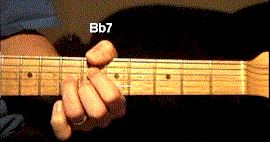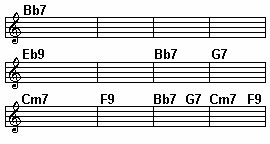Scroll through the lesson and click on notation/video/audio links to load the interactive players.
Please subscribe to get full access to all lessons for only $7.95/month PLUS 1 week free trial.

Riff Interactive lessons are
LESS expensive and
MORE interactive than alternatives!
More Info
|
|

Jam Sessions - All
Blues Styles
Lesson 4 - Bb Blues Lesson
Sample
Lyle: This is blues style jam in Bb. You'll be
learning the solos from the lesson sample and the chords and rhythm. For this
rhythm riff, I suggest using a clean setting, little or no effects. If you have a
middle position single coil pick-up, try using that, or a neck position humbucker. You have several chords to learn for this Bb Blues jam. First I'd
like to show you two different ways to play the Bb7
chord.
Bb7
chord
Bb7 chord
Lyle:
Mute the 5th (A) with your thumb and/or index finger. The tip of your thumb can
mute the A string, or the tip of your index finger on your fretting hand. There
are always many ways to play any chord. This voicing for the Bb7 has a unique
sound to it because the bass note is far away from the other chord tones by
skipping the 5th string. Learning to play it with the thumb is like how Hendrix
and other blues players play it, and it's very comfortable once you get the hang
of it.
Lyle: Here's a way I suggest playing the rest of
the chords in this progression:
chords
chords

Lyle: Notice in the pictures how relaxed my hand
grip is when using my thumb for the bass note.
Lyle: Here's a common way to play the rhythm riff
for this progression. You'll be hitting the chords on beats 2 and 4 of each
measure, just like the accents of the snare drum.
rhythm riff
1
rhythm riff
1
Lyle:
The rhythm technique used here has you muting the whole chord after each time
you hit it. Simply release your grip after each time your strike the chord and
the notes will all stop ringing. Here's a close-up video of
this:
muting
Lyle:
Rhythm riff 1 is sometimes called playing in "half time". You're playing half
note rhythms or half the beats in the measure. If you were to play in full time,
it would be like this, once for every beat in the
measure:
rhythm
riff 2
rhythm riff
2
Lyle:
The last 2 measures can be a little tricky for some of you. If it is, slow down
the TAB and use your mouse to highlight the last two bars of the rhythm riff,
click the loop button, then click play, then play the last 2 bars over and over
until you can do it at full speed and better than me.
Lyle:
Now try playing along to the jam track. Here's the whole chord progression.
Notice it's another 12 bar blues progression like many others.
chord
chart

Jam Track - Bb Blues
Lyle: The Bb minor blues scale is a good scale to
use against this jam. It will contrast nicely against the Bb7 dominant chord
sound giving you great simple blues
riffs.
Bb minor blues scale
Lyle:
The minor pentatonic has a pattern that is very useful and sometimes called the
box pattern. Here is Bb minor pentatonic using this
pattern:
box
pattern
Lyle:
Here are a couple solos I made up using notes from these scales. Notice the
“phrasing” to which these riffs are played. I'm playing a little blues riff
in-between the horn lines.
solo 1
solo 1
Lyle:
Same solo with a couple of variations:
solo 2
solo 2
Lyle:
Let's have a little fun with a single blues riff, try
this:
riff
1
Lyle:
This is a cool riff that you can play slow, medium, or fast, and you can play it
for the whole progression if you wanted! Here's an example of me playing this
riff to the jam track:
riff 1 solo example
Lyle:
Lift your finger off the string after you bend it. The heel of my picking hand
might be resting on the 6th string and is helping to mute unwanted string noise
from the bass strings.
Lyle: Here's a scale pattern you can use over
blues progressions that are based around major and dominant chords. This scale
is like a Bb minor pentatonic and major pentatonic combined. The circled notes
are the extra notes that are outside the minor pentatonic
scale.
Bb
pentatonic with extra notes
Lyle:
You're going to learn a simple solo made up from notes in this scale pattern.
Here's the first riff:
solo 3 - riff 1
Lyle:
The 7th fret, 3rd string is the major third degree of the Bb chord. You're
hammering on to it from the 6th fret, which is the flatted third
degree.
Lyle: During the chord progression when it
changes to the Eb9 chord, try doing this riff using just your index / 1st
finger:
solo 3 -
riff 2
Lyle:
The third riff to learn goes like this:
solo 3 - riff 3
Lyle: If
any of these riffs are tough, just practice them over and over for a little
while.
Lyle: Now you're ready to learn the whole solo I
made from these three riffs!
solo 3
solo 3
Lyle:
Some solos only need a couple of little riffs that you can repeat like in this
solo example. This solo ended on Bb, which is a good note to end on since that's
the key/chord we're in here.
Lyle: Speed is a byproduct of accuracy. Start
slow and see how long you can keep playing the riff. You will build up strength.
When your arm, hand, and fingers get tired, see if you can keep going just a
little longer, force yourself to relax the part of your wrist and or forearm
that is hurting before you stop playing the riff.
Lyle:
For speed and finger exercises to help build your strength and speed, check out
the instructional CD-ROM titled "Speed Techniques" in the Riff Interactive
catalog for lots of good exercises to work on building
speed.
Lyle: That's all for this lesson. Have fun
jammin'!
|
<< load notation from left
|
|
<< load audio from left
|
<< load audio from left
|